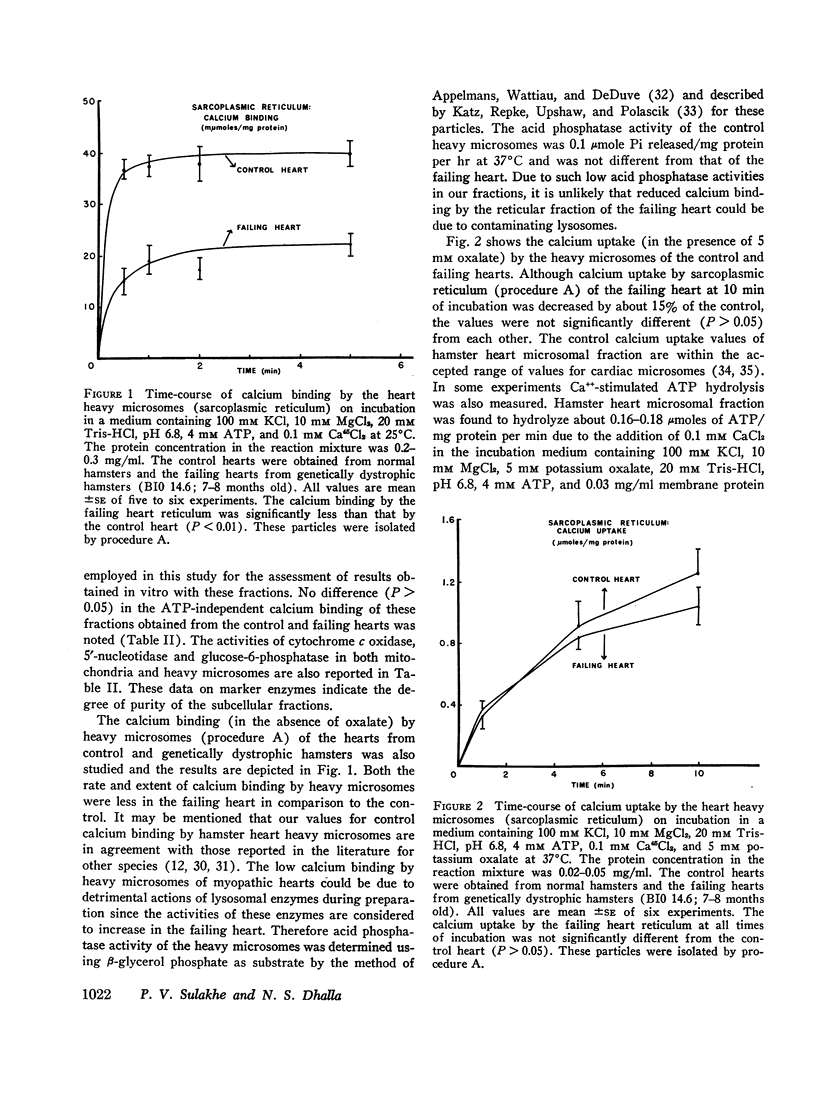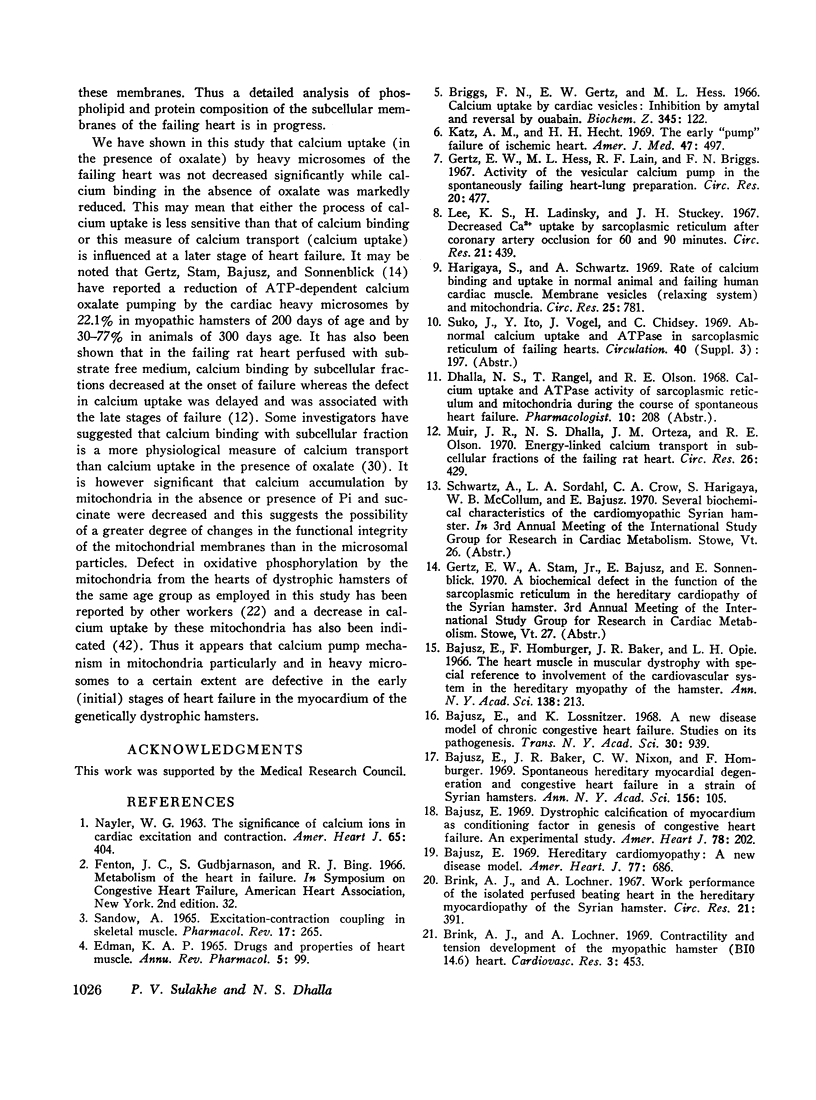Abstract
The ability of heavy microsomes and mitochondria, isolated from the control and failing hearts of genetically dystrophic hamsters (BIO 14.6 strain), to accumulate calcium was examined. The rate and extent of energy-linked calcium binding (in the absence of oxalate) by the heavy microsomes of the failing heart were markedly depressed. The calcium uptake (in the presence of 5 mM oxalate) by the heavy microsomes of the failing heart was similar to that of the control heart. On the other hand, both the rate and extent of energy-linked calcium binding (in the absence of Pi and succinate) and calcium uptake (in the presence of 4 mM Pi and 5 mM succinate) by mitochondria were greatly reduced in the failing heart in comparison to the control. No difference in the total adenosine triphosphatase activities (Ca++-Mg++ stimulated) of heavy microsomes or mitochondria was observed between the control and failing hearts. These results indicate an abnormality of subcellular membranes of the failing heart to bind calcium and support the growing conviction concerning the defective “calcium pump” as a molecular abnormality associated with a moderate degree of congestive heart failure.
Full text
PDF








Selected References
These references are in PubMed. This may not be the complete list of references from this article.
- APPELMANS F., WATTIAUX R., DE DUVE C. Tissue fractionation studies. 5. The association of acid phosphatase with a special class of cytoplasmic granules in rat liver. Biochem J. 1955 Mar;59(3):438–445. doi: 10.1042/bj0590438. [DOI] [PMC free article] [PubMed] [Google Scholar]
- Bajusz E., Baker J. R., Nixon C. W., Homburger F. Spontaneous, herditary myocardial degeneration and congestive heart failure in a strain of Syrian hamsters. Ann N Y Acad Sci. 1969 Jan 31;156(1):105–129. doi: 10.1111/j.1749-6632.1969.tb16721.x. [DOI] [PubMed] [Google Scholar]
- Bajusz E. Dystrophic calcification of myocardium as conditioning factor in genesis of congestive heart failure. An experimental study. Am Heart J. 1969 Aug;78(2):202–210. doi: 10.1016/0002-8703(69)90009-x. [DOI] [PubMed] [Google Scholar]
- Bajusz E. Hereditary cardiomyopathy: a new disease model. Am Heart J. 1969 May;77(5):686–696. doi: 10.1016/0002-8703(69)90556-0. [DOI] [PubMed] [Google Scholar]
- Bajusz E., Lossmitzer K. A new disease model of chronic congestive heart failure: studies on its pathogenesis. Trans N Y Acad Sci. 1968 May;30(7):939–948. doi: 10.1111/j.2164-0947.1968.tb02536.x. [DOI] [PubMed] [Google Scholar]
- Brink A. J., Lochner A. Contractility and tension development of the myopathic hamster (Bio 14-6) heart. Cardiovasc Res. 1969 Oct;3(4):453–458. doi: 10.1093/cvr/3.4.453. [DOI] [PubMed] [Google Scholar]
- Brink A. J., Lochner A. Work performance of the isolated perfused beating heart in the hereditary myocardiopathy of the Syrian hamster. Circ Res. 1967 Sep;21(3):391–401. doi: 10.1161/01.res.21.3.391. [DOI] [PubMed] [Google Scholar]
- Carsten M. E. Cardiac sarcotubular vesicles. Effects of ions, ouabain and acetylstrophanthidin. Circ Res. 1967 Jun;20(6):599–605. doi: 10.1161/01.res.20.6.599. [DOI] [PubMed] [Google Scholar]
- Dhalla N. S. Excitation-contraction coupling in heart. I. Comparison of calcium uptake by the sarcoplasmic reticulum and mitochondria of the rat heart. Arch Int Physiol Biochim. 1969 Dec;77(5):916–934. doi: 10.3109/13813456909059804. [DOI] [PubMed] [Google Scholar]
- EDMAN K. A. DRUGS AND PROPERTIES OF HEART MUSCLE. Annu Rev Pharmacol. 1965;5:99–118. doi: 10.1146/annurev.pa.05.040165.000531. [DOI] [PubMed] [Google Scholar]
- FANBURG B. CALCIUM IN THE REGULATION OF HEART MUSCLE CONTRACTION AND RELAXATION. Fed Proc. 1964 Sep-Oct;23:922–925. [PubMed] [Google Scholar]
- FANBURG B., GERGELY J. STUDIES ON ADENOSINE TRIPHOSPHATE-SUPPORTED CALCIUM ACCUMULATION BY CARDIAC SUBCELLULAR PARTICLES. J Biol Chem. 1965 Jun;240:2721–2728. [PubMed] [Google Scholar]
- Gertz E. W., Hess M. L., Lain R. F., Briggs F. N. Activity of the vesicular calcium pump in the spontaneously failing heart-lung preparation. Circ Res. 1967 May;20(5):477–484. doi: 10.1161/01.res.20.5.477. [DOI] [PubMed] [Google Scholar]
- Harigaya S., Ogawa Y., Sugita H. Calcium binding activity of microsomal fraction of rabbit rad muscle. J Biochem. 1968 Mar;63(3):324–331. [PubMed] [Google Scholar]
- Harigaya S., Schwartz A. Rate of calcium binding and uptake in normal animal and failing human cardiac muscle. Membrane vesicles (relaxing system) and mitochondria. Circ Res. 1969 Dec;25(6):781–794. doi: 10.1161/01.res.25.6.781. [DOI] [PubMed] [Google Scholar]
- Haugaard N., Haugaard E. S., Lee N. H., Forn R. S. Possible role of mitochondria in regulation of cardiac contractility. Fed Proc. 1969 Sep-Oct;28(5):1657–1662. [PubMed] [Google Scholar]
- Katz A. M., Hecht H. H. Editorial: the early "pump" failure of the ischemic heart. Am J Med. 1969 Oct;47(4):497–502. doi: 10.1016/0002-9343(69)90180-6. [DOI] [PubMed] [Google Scholar]
- Katz A. M., Repke D. I. Quantitative aspects of dog cardiac microsomal calcium binding and calcium uptake. Circ Res. 1967 Aug;21(2):153–162. doi: 10.1161/01.res.21.2.153. [DOI] [PubMed] [Google Scholar]
- Katz A. M., Repke D. I. Sodium and potassium sensitivity of calcium uptake and calcium binding by dog cardiac microsomes. Circ Res. 1967 Nov;21(5):767–775. doi: 10.1161/01.res.21.5.767. [DOI] [PubMed] [Google Scholar]
- Katz A. M., Repke D. I., Upshaw J. E., Polascik M. A. Characterization of dog cardiac microsomes. Use of zonal centrifugation to fractionate fragmented sarcoplasmic reticulum, (Na+ + K+)--activated ATPase and mitochondrial fragments. Biochim Biophys Acta. 1970 Jun 30;205(3):473–490. doi: 10.1016/0005-2728(70)90113-1. [DOI] [PubMed] [Google Scholar]
- LOWRY O. H., ROSEBROUGH N. J., FARR A. L., RANDALL R. J. Protein measurement with the Folin phenol reagent. J Biol Chem. 1951 Nov;193(1):265–275. [PubMed] [Google Scholar]
- Lee K. W., Ladinsky H., Stuckey J. H. Decreased Ca2+ uptake by sarcoplasmic reticulum after coronary artery occlusion for 60 and 90 minutes. Circ Res. 1967 Oct;21(4):439–444. doi: 10.1161/01.res.21.4.439. [DOI] [PubMed] [Google Scholar]
- Lochner A., Brink A. J., Van der Walt J. J. The significance of biochemical and structural changes in the development of the myocardiopathy of the Syrian hamster. J Mol Cell Cardiol. 1970 Mar;1(1):47–64. doi: 10.1016/0022-2828(70)90028-3. [DOI] [PubMed] [Google Scholar]
- Muir J. R., Dhalla N. S., Orteza J. M., Olson R. E. Energy-linked calcium transport in subcellular fractions of the failing rat heart. Circ Res. 1970 Apr;26(4):429–438. doi: 10.1161/01.res.26.4.429. [DOI] [PubMed] [Google Scholar]
- NAYLER W. G. The significance of calcium ions in cardiac excitation and contraction. Am Heart J. 1963 Mar;65:404–411. doi: 10.1016/0002-8703(63)90016-4. [DOI] [PubMed] [Google Scholar]
- Patriarca P., Carafoli E. A study of the intracellular transport of calcium in rat heart. J Cell Physiol. 1968 Aug;72(1):29–37. doi: 10.1002/jcp.1040720106. [DOI] [PubMed] [Google Scholar]
- Pretorius P. J., Pohl W. G., Smithen C. S., Inesi G. Structural and functional characterization of dog heart microsomes. Circ Res. 1969 Oct;25(4):487–499. doi: 10.1161/01.res.25.4.487. [DOI] [PubMed] [Google Scholar]
- Reynafarje B., Lehninger A. L. High affinity and low affinity binding of Ca++ by rat liver mitochondria. J Biol Chem. 1969 Feb 25;244(4):584–593. [PubMed] [Google Scholar]
- SMITH L., CAMERINO P. W. COMPARISON OF POLAROGRAPHIC AND SPECTROPHOTOMETRIC ASSAYS FOR CYTOCHROME C OXIDASE ACTIVITY. Biochemistry. 1963 Nov-Dec;2:1428–1432. doi: 10.1021/bi00906a039. [DOI] [PubMed] [Google Scholar]
- Sandow A. Excitation-contraction coupling in skeletal muscle. Pharmacol Rev. 1965 Sep;17(3):265–320. [PubMed] [Google Scholar]
- Schwartz A., Lindenmayer G. E., Harigaya S. Respiratory control and calcium transport in heart mitochondria from the cardiomyopathic Syrian hamster. Trans N Y Acad Sci. 1968 May;30(7):951–954. doi: 10.1111/j.2164-0947.1968.tb02538.x. [DOI] [PubMed] [Google Scholar]
- Sordahl L. A., Schwartz A. Effects of dipyridamole on heart muscle mitochondria. Mol Pharmacol. 1967 Nov;3(6):509–515. [PubMed] [Google Scholar]


